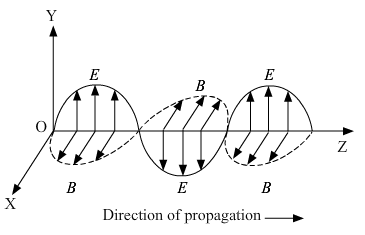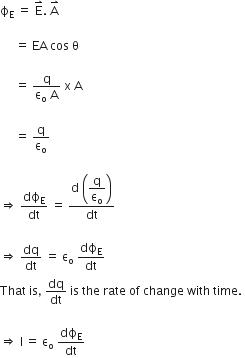What are eddy currents? Write any two applications of eddy currents.
Eddy currents are the currents induced in a metallic plate when it is kept in a time varying magnetic field. Magnetic flux linked with the plate changes and so the induced current is set up. Eddy currents are sometimes so strong, that metallic plate becomes red hot.
Applications:
i) Define mutual Inductance.
ii) A pair of adjacent coils has a mutual inductance of 1.5 H. If the current in one coil changes 20 A in 0.5 s, what is the change of flux linkage with the other coil?
i) Mutual Induction: It is the phenomenon in which a change of current in one coil induces an emf in another coil places near it. The coil in which the current changes is called the primary coil and the coil in which the emf is induced is called the secondary coil.
ii)
EMF induced is, e = - M . 

So, the flux linked with the other coil is given by, 
A bar magnet is moved in the direction indicated by the arrow between two coils PQ and CD.
Predict the directions of induced current in each coil.
In the figure, N pole is receding away coil (1), so in coil (1), the nearer faces will act as S-pole and in coil (2) the nearer face will also act as S-pole to oppose the approach of magnet towards coil (2), so current in coils will flow clockwise as seen from the side of magnet. The direction of current will be from P to Q in coil (1) and from C to D in coil (2).
Ram is a student of class X in a village school. His uncle gifted him a bicycle with a dynamo fitted in it. He was very excited to get it. While cycling during night, he could light the bulb and see the objects on the road. He, however, did not know how this device works. He asked this question to his teacher. The teacher considered it an opportunity to explain the working to the whole class.
Answer the following questions:
(a) State the principle and working of a dynamo.
(b) Write two values each displayed by Ram and his school teacher.
Dynamo:
a) Principle: Whenever a coil is rotated in a magnetic field, an emf is induced in it due to change in magnetic flux linked with the coil.
Working:
As the coil in the dynamo rotates, its inclination ( ) with respect to the field changes. Therefore, a varying emf is obtained which is given by,
) with respect to the field changes. Therefore, a varying emf is obtained which is given by,
b) Values displayed by:
Ram: curiosity, scientific aptitude, keenness to learn.
Teacher: Depth of knowledge, motivational approach, generous, dedicated.
 , where
, where  is the electric flux produced during charging of the capacitor plates.
is the electric flux produced during charging of the capacitor plates.
A moving charge produces both electric and magnetic fields, and an oscillating charge produces oscillating magnetic and electric fields. These oscillating electric and magnetic fields with respect to space and time produce electromagnetic waves.
The propagation of electromagnetic waves can be shown as:
OR
Maxwell's generalization of ampere's circuital law given by,
Consider that a parallel capacitor C is charging in a circuit.
The magnitude of electric field between the two plates will be,  , is perpendicular to the surface of the plate.
, is perpendicular to the surface of the plate.
Electric flux through the surface will be, 
